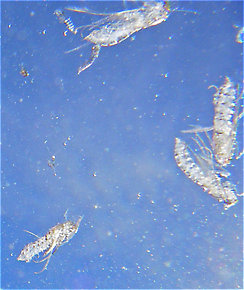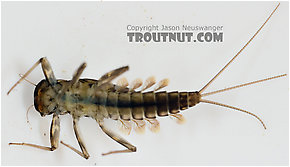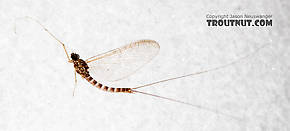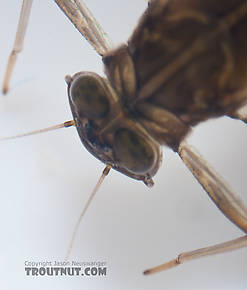Blog & Latest Updates
Fly Fishing Articles
Insects by Common Name


Mayfly Genus Cinygmula (Dark Red Quills)
Taxonomic Navigation -?-
Kingdom
Animalia (Animals)
» Phylum
Arthropoda (Arthropods)
» Class
Insecta (Insects)
» Order
Ephemeroptera (Mayflies)
» Genus Cinygmula (Dark Red Quills)
| Species in Cinygmula | ||
| Cinygmula mimus | 0 | 0 |
| Cinygmula par | 0 | 0 |
| Cinygmula ramaleyiSmall Western Gordon Quill | 0 | 0 |
| Cinygmula reticulataWestern Ginger Quill | 0 | 0 |
| Cinygmula subaequalisSmall Gordon Quill | 0 | 0 |
5 species aren't included.
Common Name
| Match | Common Name |
| Dark Red Quills |
There is only one Eastern species, Cinygmula subaequalis, and its importance is minor.
Where & When
I have found different Cinygmula species emerging throughout the summer and fall in Washington and Alaska.
Hatching Behavior
Most Cinygmula duns emerge in the surface film, but in some cases they may escape their nymphal shucks (

Here's an underwater view of the pupal shucks of several already-emerged Brachycentrus numerosus caddisflies.
Spinner Behavior
The angling literature suggests that Cinygmula spinner falls are too sporadic to be important, but I have seen Cinygmula par swarming in very good numbers, albeit on a small stream where hatch-matching wasn't needed because the hungry trout would hit anything anyway.
Nymph Biology
Cinygmula nymphs can withstand slower water than many of the other genera in the Heptageniidae family.
Pictures of 35 Mayfly Specimens in the Genus Cinygmula:
Cinygmula subaequalis (Small Gordon Quill) Mayfly Nymph View 10 PicturesThis nymph is missing a few gills, but is otherwise in good shape. It was the only one of its species which turned up in my sample.
View 10 PicturesThis nymph is missing a few gills, but is otherwise in good shape. It was the only one of its species which turned up in my sample.
 View 10 PicturesThis nymph is missing a few gills, but is otherwise in good shape. It was the only one of its species which turned up in my sample.
View 10 PicturesThis nymph is missing a few gills, but is otherwise in good shape. It was the only one of its species which turned up in my sample.Collected May 29, 2007 from Paradise Creek in Pennsylvania
Added to Troutnut.com by Troutnut on June 4, 2007
Added to Troutnut.com by Troutnut on June 4, 2007
Male Cinygmula (Dark Red Quills) Mayfly Spinner View 11 PicturesI'm unsure of the ID on this one; keys put it closest to Cinygmula reticulata, but I'm very doubtful of the species and not positive on the genus. Epeorus is another possibility, but I don't know which species it would be.
View 11 PicturesI'm unsure of the ID on this one; keys put it closest to Cinygmula reticulata, but I'm very doubtful of the species and not positive on the genus. Epeorus is another possibility, but I don't know which species it would be.
This one was collected in association with a female dun probably of the same species.
 View 11 PicturesI'm unsure of the ID on this one; keys put it closest to Cinygmula reticulata, but I'm very doubtful of the species and not positive on the genus. Epeorus is another possibility, but I don't know which species it would be.
View 11 PicturesI'm unsure of the ID on this one; keys put it closest to Cinygmula reticulata, but I'm very doubtful of the species and not positive on the genus. Epeorus is another possibility, but I don't know which species it would be.This one was collected in association with a female dun probably of the same species.
Collected July 1, 2017 from the South Fork Stillaguamish River in Washington
Added to Troutnut.com by Troutnut on July 2, 2017
Added to Troutnut.com by Troutnut on July 2, 2017
Cinygmula ramaleyi (Small Western Gordon Quill) Mayfly Nymph View 9 PicturesThis nymph is almost definitely the same species as this dun, which hatched from a nearly identical nymph from the same collection.
View 9 PicturesThis nymph is almost definitely the same species as this dun, which hatched from a nearly identical nymph from the same collection.
 View 9 PicturesThis nymph is almost definitely the same species as this dun, which hatched from a nearly identical nymph from the same collection.
View 9 PicturesThis nymph is almost definitely the same species as this dun, which hatched from a nearly identical nymph from the same collection.Recent Discussions of Cinygmula
Red Heptagenia? 30 Replies »
Posted by GONZO on Jul 19, 2011
Last reply on Jul 24, 2011 by PaulRoberts
The gills and protruding mouthparts make me think that this might be Cinygmula. I've seen red phase Rhithrogena nymphs, but have never seen this coloration in Cinygmula (or Heptagenia).
ReplyYour Thoughts On Cinygmula:
Top 10 Fly Hatches
Top Gift Shop Designs
Eat mayflies.
Top Insect Specimens
Miscellaneous Sites
Troutnut.com is copyright © 2004-2024 Jason
Neuswanger (email Jason). See my FAQ for information about use of my images.
 privacy policy
privacy policy
